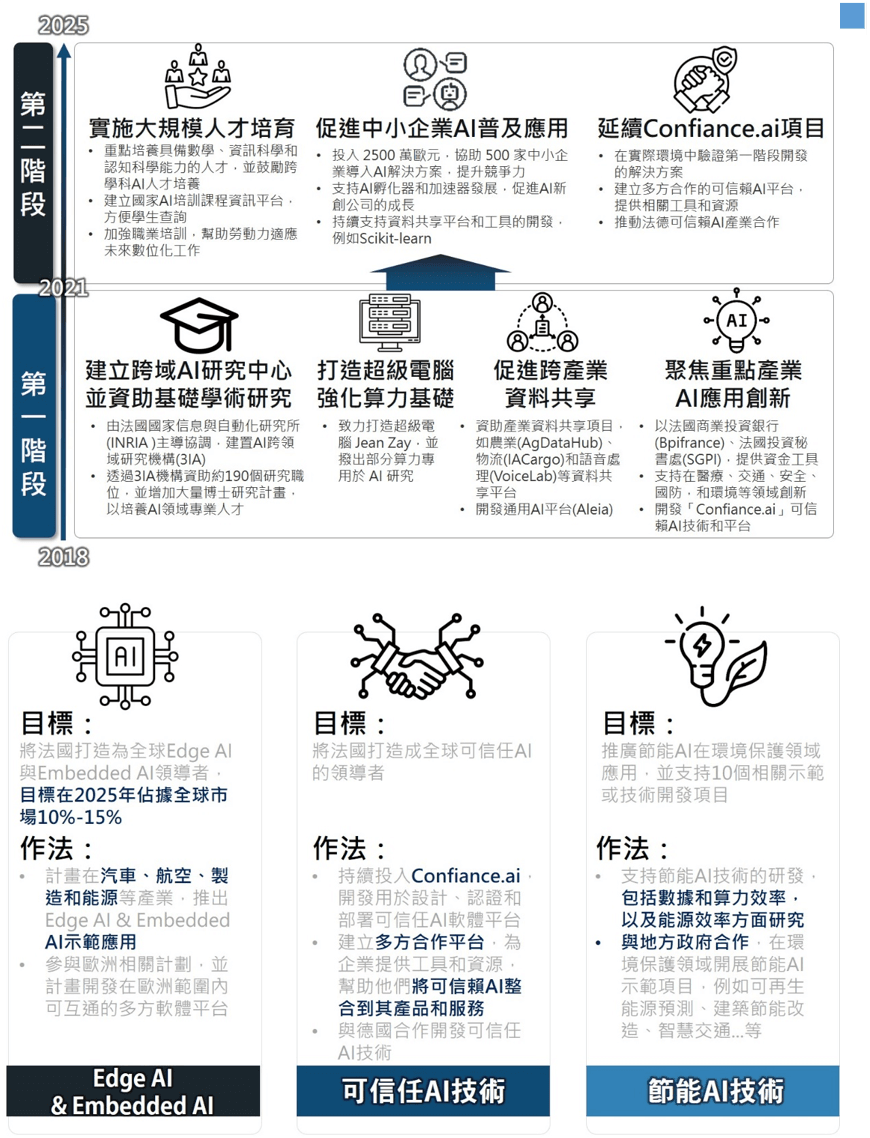Research on France’s AI Development Policy in 2024: France adopts a two-phase AI strategy that starts from laying a solid foundation to developing industrial applications, and enhances industrial competitiveness on this basis

Source: Official website of the French government, summarized by the AI HUB
Figure 1. Main implementation measures and focal technology fields in France’s two-phase AI strategy for promoting strategic industries
France’s development strategy for the AI industry can be divided into two phases. The first phase (2018-2021) focused on establishing solid infrastructure and investments. The French government strengthened France's AI R&D capabilities through four major policies: establishing a cross-field AI research center, building the supercomputer Jean Zay, facilitating cross-industry data sharing, and focusing on innovative AI applications in key industries. Among them, the cross-field AI research center integrates France’s advantages in mathematics, data science, AI, and robotics, and collaborates with companies in applied research. The supercomputer Jean Zay provides ample computing resources and accelerates the progress of AI research. The establishment of a data sharing platform facilitates data-driven AI innovations. Focusing on AI applications in key industries refers to the application of AI technology in fields such as healthcare and transportation, and produces significant economic benefits. The second phase (2021-2025) shifted the focus to transforming research results into economic benefits. The French government is accelerating the development of the AI industry through strategies such as large-scale talent cultivation, popularizing AI applications among small and medium-sized enterprises (SMEs), and developing trustworthy AI technologies. The large-scale talent cultivation plan aims to cultivate a large number of AI talents to meet the industry’s demand for talents. Popularizing AI applications among SMEs helps SMEs implement AI solutions to enhance their competitiveness. Developing trustworthy AI technologies ensures the security, reliability, and transparency of AI technologies. France focuses on developing three key technology fields, namely Edge AI and Embedded AI, trustworthy AI, and energy-saving AI.
With the rapid development of IoT and 5G technology, the next wave of AI technology that is popularized will be Edge AI and Embedded AI. The French government has spotted this trend and is actively driving the development of related industries. By combining the innovation ecosystem of the electronics engineering and information technology industries, as well as the industry advantages of large multinational companies, France aims to become a global leader in Edge AI and Embedded AI and hold 10%-15% of the global market by 2025. Specific measures include promoting demonstration applications in the automotive and aviation industries, participating in relevant European programs, and developing interoperable multi-party software platforms. In terms of trustworthy AI, the French government attaches great importance to the trustworthiness of AI and has invested considerable resources in related research. France continues to develop safety, security, and authentication solutions and validate them in the field through the Confiance.ai program. In addition, France has established an open platform for multi-party cooperation, in order to make it easier for companies to obtain and test trusted tools for AI systems. France further worked with Germany to develop trustworthy AI, jointly enhancing the competitiveness of both countries in AI. As for energy-saving AI, the French government believes that although AI is able to accelerate the response to climate change, the energy consumption of the AI system must also be taken into consideration. Therefore, France has listed energy-saving AI as a development priority, and is working with local governments to establish energy-saving AI demonstration applications in key fields, such as renewable energy and energy-saving renovations of buildings, to solve the environmental challenges of local governments.